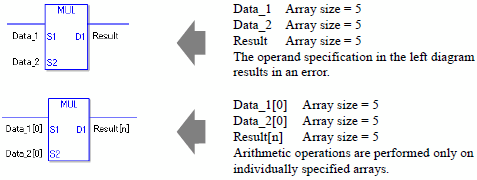
The MUL and MULP instructions are multiplication instructions. When a MUL instruction is executed, S1 will be multiplied by S2 and the result is stored in D1.
The MUL and MULP instructions always pass power. When using MUL and MULP instructions, if the types of variables specified in operands S1, S2, and D1 are not the same, an error will occur. Designate the same variable type in all operands S1, S2, and D1.
Refer to the following for specifying a constant.
When operand D1 is an integer variable

When operand D1 is an integer variable and you want to input hexadecimal values in operands S1 and S2
When 0x (zero and lower case "x") is input, the following values become hexadecimal values.

When operand D1 is a float variable
When 0f (zero and lower case "f") is input, the following values are interpreted as float values.

When operand D1 is a real variable
When 0r (zero and lower case "r") is input, the following values are interpreted as real values.

When Multiplying Data in a Specified Array (Integer Variable Array)
Specify the array using Data [0] or Data [N] (N indicates an integer variable).
When operands S1, S2, and D1 specify the entire array, an error will occur even if the specified variables are the same type.
